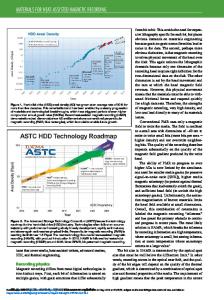Materials for Multilayer Recording
- PDF / 603,583 Bytes
- 6 Pages / 612 x 792 pts (letter) Page_size
- 1 Downloads / 337 Views
Materials for Multilayer Recording
Tom D. Milster and Yan Zhang Abstract An attractive feature of optical discs is their capacity. Recent research has indicated that the capacity of optical discs can be increased by using multiple layers of bitwise data. Layers are spaced along the depth dimension of the discs. Individual layers are recorded and information is retrieved in a manner that is very similar to conventional optical disc systems using a single layer. The data capacity of each layer is nearly equal to the capacity of a single layer, thus increasing the capacity of a disc by a factor equal to the number of layers. In fact, dual-layer optical discs are already commercially available. With some storage materials, it is possible to record hundreds of data layers. However, system engineering trade-offs, like readout speed, are of concern. More conventional materials can also be used for multilayer recording, but the number of layers is limited by the transmission properties of each layer. This article reviews the materials systems for multilayer recording, the interplay between materials properties and performance, and the optical systems used for multilayer recording. Keywords: layered, memory, optical.
Introduction Bitwise volumetric data storage techniques are attractive candidates for increasing data capacity in optical storage devices. The configuration of the optical system for this type of recording is similar to that of conventional disc systems, in that a spinning disc is illuminated by a laser beam focused into the disc by an objective lens. Data are recorded and read out as mark patterns in spiral tracks. The objective lens moves on an actuator that responds to servo signals in order to keep the focused beam aligned correctly on the data.1 A significant difference between conventional recording and bitwise volumetric recording is that many more layers are accessed in volumetric systems. As shown in Figure 1, a laser beam focuses through the substrate to access data layers. Bitwise volumetric recording is distinctly different from volumetric holographic recording, in that holographic recordings store data as collections of gratings throughout the depth of the material. In this article, several material candidates for multilayered recording are
318
reviewed and systems considerations are outlined.
microscopy, can be used to provide adequate signal-to-noise ratio. The advantage of a 2P absorption process is its ability to selectively excite molecules inside the focus volume without affecting molecules elsewhere in the storage material. This selection may be achieved because the laser photons have less energy than the energy gap between the ground state and the first allowed electronic level. Therefore, photons propagate through the medium without being absorbed by a one-photon process. However, in the vicinity of the laser beam focus, the intensity is high enough that two photons can combine to excite carriers across the energy gap. The transition probability of a 2P absorption process partly depen
Data Loading...











